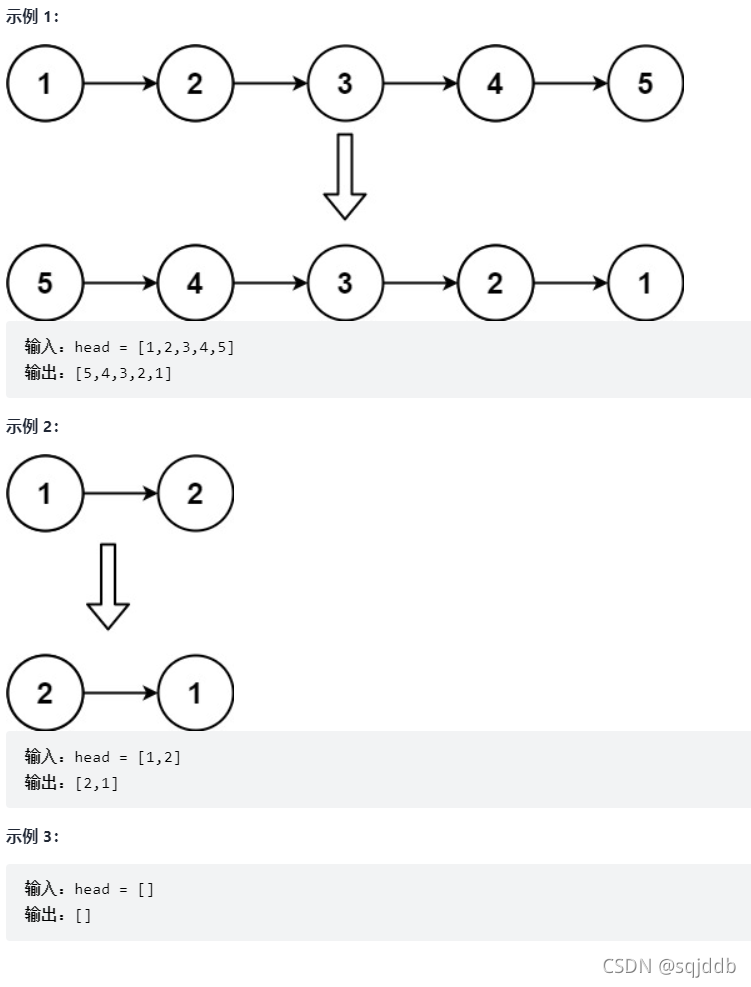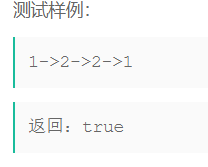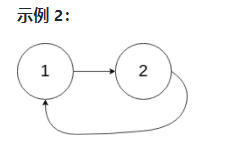链表操作,万变不离其宗
1. 链表基本介绍
链表是一种物理存储结构上非连续、非顺序的存储结构,数据元素的逻辑顺序是通过链表中的指针链接次序实现的 。实际中链表的结构非常多样,实际中最常用还是两种结构:
- 无头单向非循环链表:结构简单,一般不会单独用来存数据。实际中更多是作为其他数据结构的子结构,如哈希桶、图的邻接表等等。
- 带头双向循环链表:结构最复杂,一般用在单独存储数据。结构虽然复杂,但在操作上有很多优势。
2. 无头单向不循环链表
这是常用的一种链表,oj题中经常使用,面试时也常用
实现链表的完整程序
3. 带头双向循环链表

带头双向循环链表的优势体现在对它的基本操作中:
实现一个有增删改等功能的带头双向循环链表
4. 链表经典题目分析
①移除链表元素
给你一个链表的头节点 head 和一个整数 val ,请你删除链表中所有满足 Node.val == val 的节点,并返回 新的头节点 。
题目答案及分析
②反转链表
给你单链表的头节点 head ,请你反转链表,并返回反转后的链表

方法一:
定义三个指针n1 n2 n3,n1记录上一个节点位置,n2为当前位置,n3是下一个节点位置,修改时当前位置指向上一个位置,然后n1,n2,n3都后移。如图:

程序如下:
struct ListNode* reverseList(struct ListNode* head){
if (!head)
return head;
struct ListNode* n1 =NULL;//记录上个节点位置
struct ListNode* n2 = head;//当前位置
struct ListNode* n3 = head->next;//记录下个位置
while (n2)
{
n2->next=n1;
n1=n2;
n2=n3;
if(n3)
n3=n3->next;
}
return n1;
}
方法二:
遍历节点依次头插,使初始尾节点变成新头结点
struct ListNode* reverseList(struct ListNode* head){
struct ListNode* newhead=NULL;
struct ListNode* cur=head;
while(cur)
{
struct ListNode* next=cur->next;
cur->next=newhead;
newhead=cur;
cur=next;
}
return newhead;
}
③链表的中间结点
给定一个头结点为 head 的非空单链表,返回链表的中间结点。
如果有两个中间结点,则返回第二个中间结点。
思路:快慢指针法,慢指针走一步,快指针走两步。
struct ListNode* middleNode(struct ListNode* head){
struct ListNode* fast=head;
struct ListNode* low=head;
while(fast&&fast->next)
{
low=low->next;
fast=fast->next->next;
}
return low;
}
④链表中倒数第k个节点
题目链接

思路:
快慢指针法更为方便,快指针先走k步,然后快慢指针同时走,注意考虑特殊情况。


程序如下:
struct ListNode* FindKthToTail(struct ListNode* pListHead, int k ) {
if(!pListHead)
return NULL;
struct ListNode* low=pListHead;
struct ListNode* fast=pListHead;
while(k--)
{
if(fast==NULL)
return NULL;
fast=fast->next;
}
while(fast)
{
low=low->next;
fast=fast->next;
}
return low;
}
⑤整合两个有序链表
思路:创建新头,比较两个链表当前节点数值,小的在新链表后尾插,剩余的全部接上即可
程序如下:
struct ListNode* mergeTwoLists(struct ListNode* l1, struct ListNode* l2){
if(!l1)
return l2;
if(!l2)
return l1;
struct ListNode* newhead=NULL;
struct ListNode* tail=NULL;
struct ListNode* cur1=l1;
struct ListNode* cur2=l2;
if(cur1->val<cur2->val)
{
newhead=l1;
tail=l1;
cur1=cur1->next;
}
else
{
newhead=l2;
tail=l2;
cur2=cur2->next;
}
while(cur1&&cur2)
{
if(cur1->val<cur2->val)
{
tail->next=cur1;
tail=cur1;
cur1=cur1->next;
}
else
{
tail->next=cur2;
tail=cur2;
cur2=cur2->next;
}
}
if(cur1==NULL)
tail->next=cur2;
else
tail->next=cur1;
return newhead;
}
小技巧:
创建新头那段代码有点长,可以开辟一个哨兵节点,然后直接开始比较,最后返回要求的指针,释放哨兵节点

⑥排序链表部分节点
现有一链表的头指针 ListNode* pHead,给一定值x,编写一段代码将所有小于x的结点排在其余结点之前,且不能改变原来的数据顺序,返回重新排列后的链表的头指针
思路:开辟两个新头,小于x的链接在一起,其余链接在一起,然后两条链链接在一起
程序如下:
class Partition {
public:
ListNode* partition(ListNode* pHead, int x) {
struct ListNode* lessHead,*lessTail,*greaterHead,*greaterTail;
lessHead=lessTail=(struct ListNode*)malloc(sizeof(struct ListNode));
greaterHead=greaterTail=(struct ListNode*)malloc(sizeof(struct ListNode));
struct ListNode* cur=pHead;
while(cur)
{
if(cur->val<x)
{
lessTail->next=cur;
lessTail=cur;
}
else
{
greaterTail->next=cur;
greaterTail=cur;
}
cur=cur->next;
}
greaterTail->next=NULL;
lessTail->next=greaterHead->next;
struct ListNode* p=lessHead->next;
free(lessHead);
free(greaterHead);
return p;
}
};
⑦链表的回文结构
对于一个链表,请设计一个时间复杂度为O(n),额外空间复杂度为O(1)的算法,判断其是否为回文结构。
给定一个链表的头指针A,请返回一个bool值,代表其是否为回文结构。保证链表长度小于等于900。
思路:找到链表中间节点,将后半条链逆序,遍历比较。(可参考②,③)
class PalindromeList {
public:
//找到中间节点
struct ListNode* middleNode(struct ListNode* head)
{
struct ListNode* fast=head;
struct ListNode* low=head;
while(fast&&fast->next)
{
low=low->next;
fast=fast->next->next;
}
return low;
}
//链表逆序
struct ListNode* reverseList(struct ListNode* head)
{
struct ListNode* newhead=NULL;
struct ListNode* cur=head;
while(cur)
{
struct ListNode* next=cur->next;
cur->next=newhead;
newhead=cur;
cur=next;
}
return newhead;
}
bool chkPalindrome(ListNode* A)
{
struct ListNode * mid = middleNode(A);
struct ListNode * rhead = reverseList(mid);//逆序后的新头为rhead
struct ListNode *head = A;
while(head&&rhead)
{
if(head->val!=rhead->val)
return false;
head=head->next;
rhead=rhead->next;
}
return true;
}
};
⑧链表的公共节点
给你两个单链表的头节点 headA 和 headB ,请你找出并返回两个单链表相交的起始节点。如果两个链表没有交点,返回 null
思路:先判断链表是否相交,相交的链表最后一个节点应该是一样的。
如果相交,计算两链表的长度,定义两个指针指向两链表,长链表先走两链表长度差值步,然后两指针同时走,当走到公共节点前一个位置,next的值相同,找到。
struct ListNode *getIntersectionNode(struct ListNode *headA, struct ListNode *headB) {
//确定两链表长度
struct ListNode * curA = headA;
struct ListNode * curB = headB;
int lenA = 0, lenB = 0;
while(curA)
{
lenA++;
curA=curA->next;
}
while(curB)
{
lenB++;
curB=curB->next;
}
//假设A更长,如果不是,交换即可
struct ListNode * longList =headA;
struct ListNode * shortList =headB;
if(lenA<lenB)
{
longList=headB;
shortList=headA;
}
//长链先走差值步
int gap = abs(lenA-lenB);
while(gap--)
{
longList = longList->next;
}
//同时走,判断有无相交
while(longList&&shortList)
{
if(longList == shortList)
{
return longList;
}
shortList = shortList->next;
longList = longList->next;
}
return NULL;
}
⑨带环链表
a.判断链表是否有环
给定一个链表,判断链表中是否有环
思路:快慢指针同时从头走,慢指针走一步,快指针走两步,如果有环,快慢指针会相遇
程序如下:
bool hasCycle(struct ListNode *head) {
struct ListNode* low=head;
struct ListNode* fast=head;
while(fast&&fast->next)
{
low=low->next;
fast=fast->next->next;
if(low==fast)
{
return true;
}
}
return false;
}
b.返回带环链表的入环位置
给定一个链表,返回链表开始入环的第一个节点。 如果链表无环,则返回 null。
思路:
有这样一个结论:用a中方法判断链表是否有环,如果有,可以找到快慢指针相遇处,使一个指针从相遇处一步一步走,使另一个指针同时从头一步一步走,他们最终会在入环处相遇
证明过程:
(该过程值得读者思考的细节很多)

程序如下:
struct ListNode *detectCycle(struct ListNode *head) {
struct ListNode* low=head;
struct ListNode* fast=head;
while(fast&&fast->next)
{
low=low->next;
fast=fast->next->next;
if(low==fast)
{
struct ListNode* meet=low;
while(meet!=head)
{
head=head->next;
meet=meet->next;
}
return meet;
}
}
return NULL;
}
⑩每个节点包含随机指针的链表
给你一个长度为 n 的链表,每个节点包含一个额外增加的随机指针 random ,该指针可以指向链表中的任何节点或空节点。
构造这个链表的 深拷贝。 深拷贝应该正好由 n 个 全新 节点组成,其中每个新节点的值都设为其对应的原节点的值。新节点的 next 指针和 random 指针也都应指向复制链表中的新节点,并使原链表和复制链表中的这些指针能够表示相同的链表状态。复制链表中的指针都不应指向原链表中的节点

思路:
首先想到,遍历复制,但是当前位置的随机指针指向的节点可能还没有创建出来
方法之一:
在每个节点后插入一个新节点,然后给新节点的随机指针赋值,最后把刚才插入的所有新节点链接起来就复制成功了。
随机指针赋值的依据:每个新插入的节点复制的是现在它之前的老节点,老节点根据随机指针访问到另一个老节点,这个访问到的老节点后也插入了新节点,老节点——老节点 和 新节点——新节点的 的相对距离一样,随机指针的指向就确定了。
程序如下:
struct Node* copyRandomList(struct Node* head) {
if(head==NULL)
return NULL;
//拷贝节点在原来节点之后
struct Node* cur=head;
while(cur)
{
struct Node* next=cur->next;
struct Node* copy=(struct Node*)malloc(sizeof(struct Node));
copy->val=cur->val;
cur->next=copy;
copy->next=next;
cur=next;
}
//给随机节点赋值
cur=head;
while(cur)
{
struct Node* copy=cur->next;
if(cur->random)
{
copy->random=cur->random->next;
}
else
{
copy->random=NULL;
}
cur=copy->next;
}
//把新节点链接起来
struct Node* copyhead,*copytail;
copyhead=copytail=(struct Node*)malloc(sizeof(struct Node));
cur=head;
while(cur)
{
struct Node* copy=cur->next;
struct Node* next=copy->next;
copytail->next=copy;
copytail=copy;
cur->next=next;
cur=next;
}
struct Node* p=copyhead;
copyhead=copyhead->next;
free(p);
return copyhead;
}




